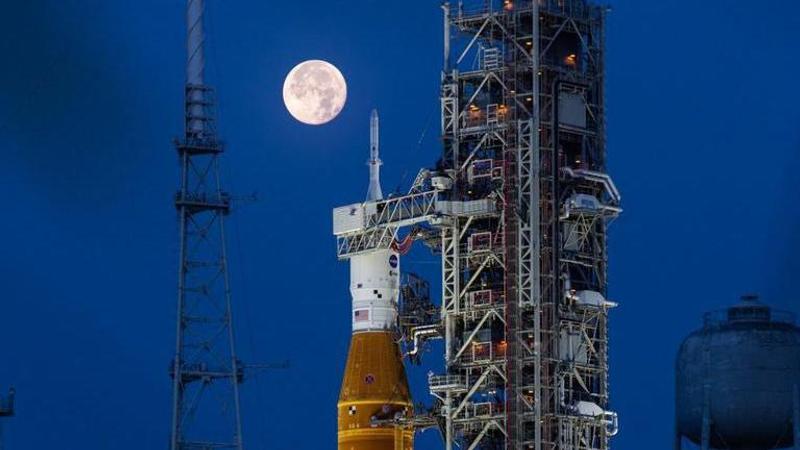Published 17:02 IST, September 3rd 2022
Artemis I: As NASA re-attempts launch, must know facts about the historic mission to Moon
NASA has begun the official countdown for the launch of Artemis I on September 3 with the loading of both liquid oxygen and liquid hydrogen.

NASA is making a second attempt at launching the Artemis 1 mission from Kennedy Space Center in Florida on September 3, which will begin a series of many firsts. NASA has kickstarted the official countdown for the launch of Artemis I with the loading of both liquid oxygen and liquid hydrogen. The coverage of tanking operations began at 3:15 pm IST and the launch operations will air starting at 9:45 pm IST. Ahead of the launch, let us take a look at some of the must-know facts about the historic mission.
What does the name 'Artemis' mean?
The name is derived from the Greek goddess Artemis, who is also the twin sister of Apollo. As we know, Apollo was NASA's Program that saw astronauts Neil Armstrong and Buzz Aldrin land on the Moon during the Apollo 11 mission in 1969. The Artemis Program, on the other hand, is being kickstarted with Artemis I and will send astronauts back to the Moon under Artemis III planned for 2025.
SLS will become the most powerful rocket to launch from Earth
With a maximum thrust capacity of 8.8 million pounds, the SLS rocket will become the most powerful launch vehicle to ever liftoff from the Earth. Standing 322 feet tall, the rocket is capable of transporting 27 metric tonnes of payload including four astronauts in deep space. According to NASA, it is 15% more powerful than the Saturn V rocket used during the Apollo missions.
It weighs over 26 lakh kg (5.75 million lbs) and its core stage consisting of four RS-25 engines will burn 7,35,000 gallons of liquid propellant to create two million pounds of thrust for eight minutes. Besides, the twin rocket boosters will burn for the first two minutes after launch and consume over two million pounds of solid propellant to create seven million pounds of thrust.
Orion will travel farther than any spacecraft
The Orion Crew Module, which will be powered by the European Space Agency's (ESA) Service Module, will fly farther than any human-rated spacecraft has ever flown. According to the mission profile, Orion will get as close as 100 km above the lunar surface but use the Moon's gravity to fly around 64,000 km (40,000 miles) beyond the Moon. At its farthest point, Orion will be 4,50,000 kilometers (280,000 miles) from the Earth and will travel over two million kilometres during the 42-day-long mission.
(Orion's planned flight path; Image: NASA)
Artemis I will use the first solar-powered spacecraft
Under Artemis I, Orion will become the first solar-powered spacecraft to be used for exploration missions. The spacecraft's solar panels, which would span 62 feet after unfurling, consist of 15,000 solar cells and would produce 11 KW of power for the Crew Module. These solar panels will be unfurled eighteen minutes after launch to charge the batteries of the Service Module. The Orion spacecraft is composed of the Crew Module mounted over the Service Module (Orion's engine).
Three mannequins will gather crucial data to help astronauts
The uncrewed Orion spacecraft consists of three mannequins that are launched to gather crucial data to be used during future astronaut missions. One of these mannequins is the 'Moonikin Campos' which has been named after NASA engineer Arturo Campos and is equipped with sensors to gather data on spaceflight such as the effects of vibrations during a rocket launch.
The other two are female torsos named Helga and Zohar that will don a special radiation suit named 'AstroRad' that will measure the amount of radiation astronauts would experience during their lunar trip inside Orion. These two mannequins are a part of a study called Matroshka AstroRad Radiation Experiment (MARE), a joint initiative of the German and Israel Space Agency.
Orion will also carry 10,000 items to space
The spacecraft is also carrying 10,000 items that are part of NASA's Official Flight Kit (OFK). Weighing a little over 54 kg (120 pounds), the kit includes 2,500 Artemis I mission pins and 2,775 Artemis I mission patches, a Moon rock collected during Apollo 11, a bolt from the F-1 engine of the Apollo 11 spacecraft, a 3D-printed replica of the Greek goddess Artemis, lego toys, a pebble from the shore of the Dead Sea, some tree seeds and much more.
Updated 17:16 IST, September 3rd 2022




